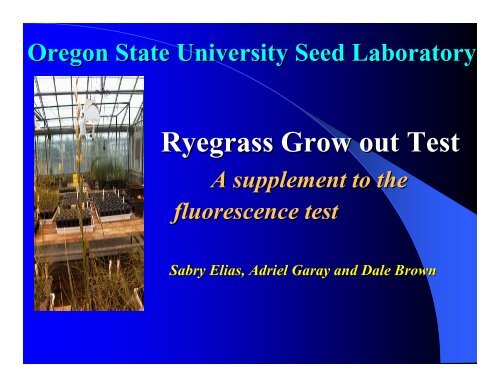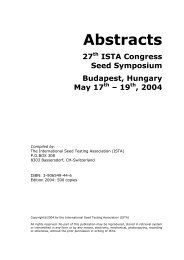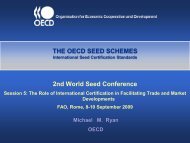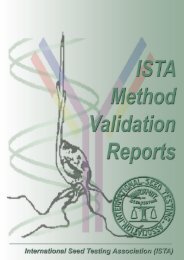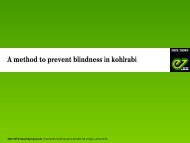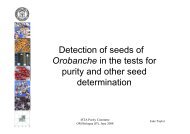Ryegrass Grow out Test - International Seed Testing Association
Ryegrass Grow out Test - International Seed Testing Association
Ryegrass Grow out Test - International Seed Testing Association
You also want an ePaper? Increase the reach of your titles
YUMPU automatically turns print PDFs into web optimized ePapers that Google loves.
Oregon State University <strong>Seed</strong> Laboratory<br />
<strong>Ryegrass</strong> <strong>Grow</strong> <strong>out</strong> <strong>Test</strong><br />
A supplement to the<br />
fluorescence test<br />
Sabry Elias, Adriel Garay and Dale Brown
Annual ryegrass<br />
Perennial ryegrass
Background<br />
! Fluorescence test sometimes overestimates annual<br />
ryegrass contamination in perennial ryegrass seed<br />
lots resulting in false labeling and financial loss to<br />
ryegrass growers.<br />
! Genetically, fluorescence trait is not always<br />
associated with the annual form of ryegrass.<br />
! Environmental conditions affect the level of<br />
fluorescence from year to year and from location to<br />
location.
Mean % annual ryegrass seeds in 45 perennial<br />
seed lots tested at the OSU <strong>Seed</strong> Lab using the<br />
fluorescence test and the grow-<strong>out</strong> <strong>out</strong> test<br />
% annual type based on<br />
FL <strong>Test</strong><br />
<strong>Grow</strong>-<strong>out</strong> <strong>out</strong> <strong>Test</strong><br />
10.07 3.11
Background<br />
! As the concern regarding the fluorescence<br />
test increased, many ryegrass growers<br />
asked to allow the use of grow-<strong>out</strong> <strong>out</strong> test to<br />
supplement the fluorescence test.<br />
! The grow <strong>out</strong> test has proven to give more<br />
realistic results on the level of annual<br />
ryegrass contamination in perennial seed<br />
lots.
The grow-<strong>out</strong> <strong>out</strong> test in the Federal <strong>Seed</strong><br />
Act Regulations<br />
! Sec. 201.58a of the FSA Regulations indicates<br />
that ryegrass samples can be grown <strong>out</strong> and<br />
plants examined to determine if they are<br />
annual or perennial.
<strong>Test</strong> Procedure<br />
Sample size for transplanting:<br />
• All fluorescent seedlings (from the fluorescence<br />
test),<br />
• A minimum of 20 random non-fluorescing perennial<br />
seedlings from the sample being tested (perennial<br />
checks), and<br />
• a minimum of 20 annual seedlings (annual checks)<br />
<strong>Test</strong> period and final evaluation:<br />
Plants should be evaluated after ab<strong>out</strong> 42 days of<br />
transplanting the fluoresced seedlings, or when full<br />
heading of the annual check sample is achieved.
A National Referee Study<br />
! A national referee study was coordinated by the<br />
OSU <strong>Seed</strong> Lab to validate and standardize the<br />
ryegrass grow-<strong>out</strong> <strong>out</strong> test procedure.<br />
! Based on the study, a full protocol including<br />
procedure, calculations and an appropriate<br />
tolerance table will be published in the Cultivar<br />
Purity Handbook by Oct. 2002.
Transplanting in cell trays
(low light intensity)
<strong>Ryegrass</strong> grow-<strong>out</strong> <strong>out</strong> test in green house
Plants should be classified as follows:<br />
a. Perennial types: Plants that have similar<br />
characteristics as the perennial checks and have not<br />
headed.<br />
b. Annual types: : Plants that have headed and/or do not<br />
resemble the perennial check characteristics (e.g.,<br />
have wide blades, light color, elongated stems).
Control perennial ryegrass– No heads, narrow dark blades
Annual type<br />
Perennial type<br />
<strong>Ryegrass</strong>
Formulas:<br />
formulas were developed to calculated the<br />
% of annual and perennial ryegrass types.<br />
% Annual ryegrass =<br />
Number<br />
of<br />
fluorescen t plants that have headed<br />
Total number of normal seedlings x<br />
or resemble annual<br />
Survival factor<br />
checks<br />
Survival<br />
factor =<br />
No. of fluorescent seedlings − No.<br />
of plants<br />
No.<br />
of fluorescen t<br />
that died<br />
seedlings<br />
during<br />
the<br />
grou <strong>out</strong><br />
test<br />
% Perennial ryegrass = % Pure ryegrass - % Annual ryegrass
Example<br />
% of pure ryegrass (obtained in the purity analysis) = 99.12<br />
No. of normal seedlings (<strong>out</strong> of 400 seeds planted) = 380<br />
No. of fluorescent seedlings = 12<br />
Example 2. (In case of mortality during the grow-<strong>out</strong> test)<br />
% of pure ryegrass (obtained in the purity analysis) = 99.12<br />
No. of plants that died during or after transplanting = 3<br />
Number of annual type plants at the end of the grow-<strong>out</strong> test = 4<br />
No. of normal seedlings (<strong>out</strong> of 400 seeds planted) = 380<br />
No. of fluorescent seedlings = 12<br />
No. of plants that died during or after transplanting = 3<br />
Survival Survival factor factor = =<br />
12<br />
−<br />
12<br />
3<br />
=<br />
0.75<br />
Annual type =<br />
380<br />
4<br />
x<br />
0.75<br />
x<br />
99.12<br />
=<br />
1.39<br />
% Perennial <strong>Ryegrass</strong> = 99.12 – 1.39 = 97.73
Tolerances for grow-<strong>out</strong> <strong>out</strong> tests:<br />
• Table 4 in Sec. 202.62 of the FSA Regulations<br />
contains tolerances appropriate for use when<br />
comparing results of grow-<strong>out</strong> <strong>out</strong> tests.<br />
• Table 4 is adopted from Table V1 'Trueness to variety 2<br />
estimates, 5% 1-way 1<br />
test' " Handbook of tolerances,<br />
Miles, 1963 page 667.<br />
• We used this table in the <strong>Grow</strong>-<strong>out</strong> <strong>out</strong> test considering<br />
the label as an initial grow-<strong>out</strong> <strong>out</strong> test (or first estimate) and a<br />
subsequent test as a second estimate.
• Table V2 "Trueness to variety, 1 specification and<br />
1 estimate, 5% 1-way 1<br />
test; Miles. 1963 page 668.<br />
• The specification is the % of varietal fluorescence<br />
(VFL) that is established by the breeder of each<br />
variety and is listed in the AOSCA National Grass<br />
Variety Review Board. This VFL value is assumed<br />
to have only one source of variation which is the<br />
variation in the seed or sample variation. In this case<br />
Table V2 is appropriate for use.
Tolerance Example<br />
An initial grow-<strong>out</strong> test reported 98.0% perennial ryegrass,<br />
but a subsequent test showed only 94.4%. In the second test<br />
380 normal seedlings were obtained <strong>out</strong> of the 400 seeds<br />
planted for the fluorescence test. Are these two samples within<br />
tolerance?<br />
• Apparent test discrepancy = 98 – 94.4 = 3.6%<br />
• Average of the two tests is (98 + 94.4)/2 = 96.2 (96%).<br />
• In Table 4, 380 is between column 200 and 400 at row 96/4<br />
• so the tolerance is between 3.2 and 2.3 and must be<br />
computed by interpolation.
• Since 380 plants is 180/200 of the way between 200 and<br />
400, then the allowable tolerance is 180/200 of the way<br />
between 3.2 to 2.3.<br />
• Therefore, the interpolated tolerance is: 3.2 - [(3.2 – 2.3) x<br />
180/200)] = 2.4.<br />
• The test discrepancy of 3.6 exceeds the tolerance 2.4, so the<br />
tests are <strong>out</strong> of tolerance.
Reporting and calculations:<br />
! A grow <strong>out</strong> test report would include the<br />
percentages of perennial, and annual types<br />
according to the grow <strong>out</strong> formulas.<br />
! Purity results based on the grow-<strong>out</strong> <strong>out</strong> test may<br />
differ from those based on the fluorescence test<br />
in both the ‘pure seed’ and ‘other crop’<br />
components.<br />
! When grow-<strong>out</strong> <strong>out</strong> test is used to determine the<br />
percentage of annual and perennial ryegrass in<br />
a sample, purity report should include the<br />
following statement: “Pure seed is based on<br />
grow-<strong>out</strong> <strong>out</strong> test”.
AASCO, AOSCA, and ASTA<br />
Resolutions<br />
! AASCO passed a resolution in Feb, 2001 stating that<br />
whenever a lot is tested for purity based on a grow <strong>out</strong><br />
test, it shall be stated on the label as such. This allows<br />
to label and sell PRG based on grow-<strong>out</strong> <strong>out</strong> test<br />
! AOSCA passed a motion on July 3, 2001 supporting<br />
use of the grow-<strong>out</strong> <strong>out</strong> test as an option to the fluorescence<br />
testing until a more accurate, faster test is approved.<br />
" ASTA, , also supports the grow-<strong>out</strong> <strong>out</strong> test.
Research Activities<br />
The OSU <strong>Seed</strong> Lab has conducted the following studies:<br />
1) determination of light intensity and time of exposure for<br />
optimum rate and speed of growth and heading of PRG.<br />
2) determination of optimum plant spacing/ containers for the<br />
grow-<strong>out</strong> <strong>out</strong> of RG.<br />
3) comparison of two methods for the grow-<strong>out</strong> <strong>out</strong> of RG:<br />
transplanting fluorescent seedlings vs. stand alone test<br />
(direct planting of seeds).<br />
! The objective of the above studies was to optimize grow-<strong>out</strong><br />
<strong>out</strong><br />
test conditions for fast, accurate results.<br />
! The primary results emphasized the importance of light<br />
intensity, continuous light exposure (24 h) during the course<br />
of the test, and using cell containers for planting.
Current/potential Research Activities<br />
Reed Barker & Scott Warnke, USDA. Conducting genetic<br />
mapping studies to examine annual-perennial inheritance,<br />
and located genomic regions suitable for test development.<br />
Jim Dombrowski, USDA. . Investigating the possibility of<br />
identifying differentially expressed genes by subtractive<br />
hybridization of cDNA libraries.<br />
Hiro Nonogaki, OSU. Plans to identify the specific protein or<br />
mRNA using subtraction PCR to identify the gene(s)<br />
specifically expressed in annual or perennial ryegrass, then<br />
isolate the cDNA and develop an ELISA test.<br />
Sabry Elias, OSU <strong>Seed</strong> Lab. Preliminary exploration shows<br />
promise for IEF tests based on phosphohexose isomerase and<br />
esterase enzymes. Proposing to develop and verify useable<br />
lab tests.
Current/potential Research Activities<br />
Nicholas Hill, U of GA. Initial work with protein<br />
monoclonal antibodies and ELISA tests has been done. No<br />
data are available.<br />
Glen Freeman, Rutgers Univ. Preliminary work with<br />
HPLC (liquid chromatography) shows potential.<br />
Proposing to develop ELISA assay test.
For comments or questions contact<br />
Sabry.elias<br />
elias@oregonstate.eduedu


